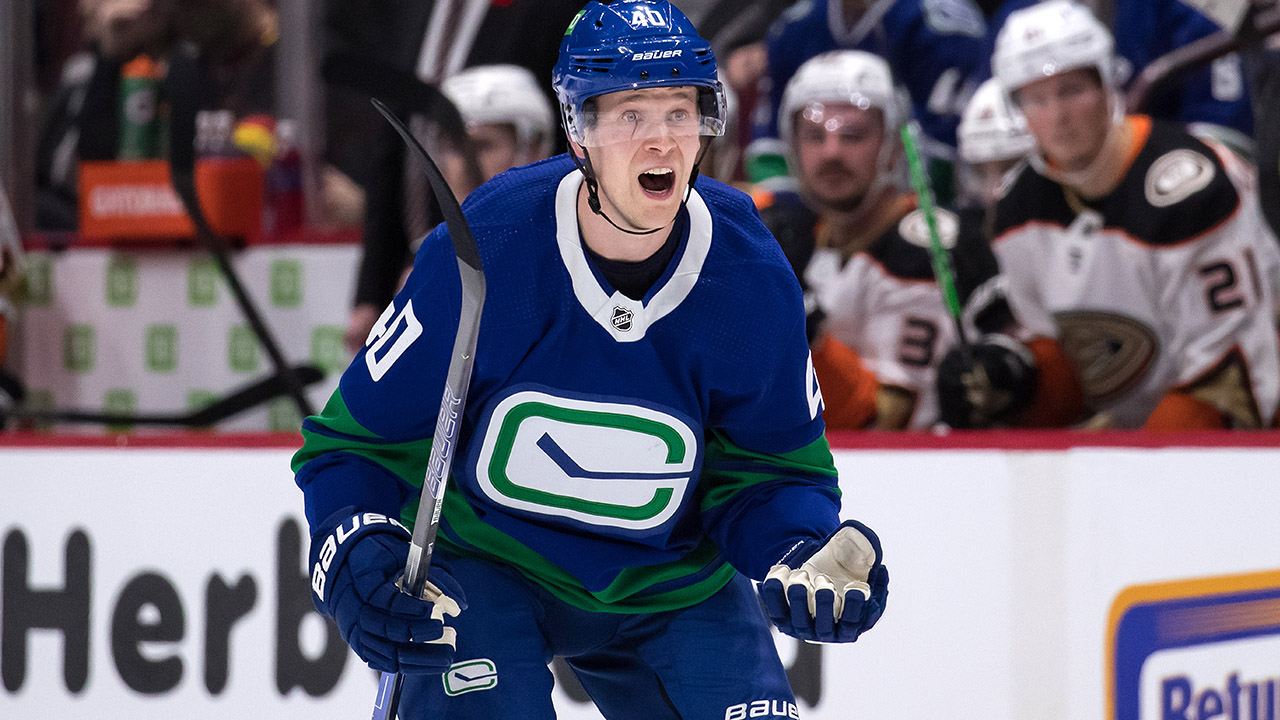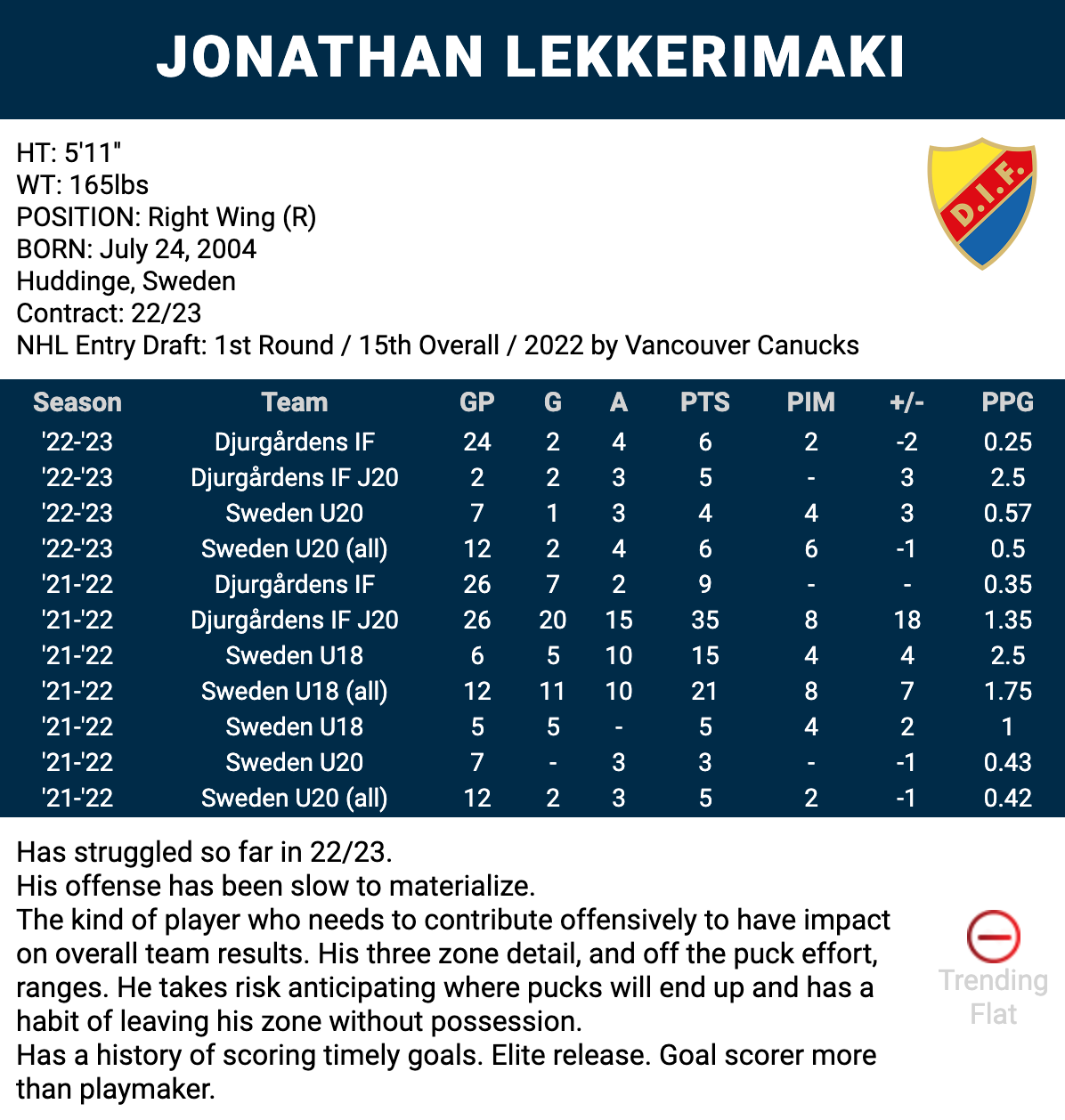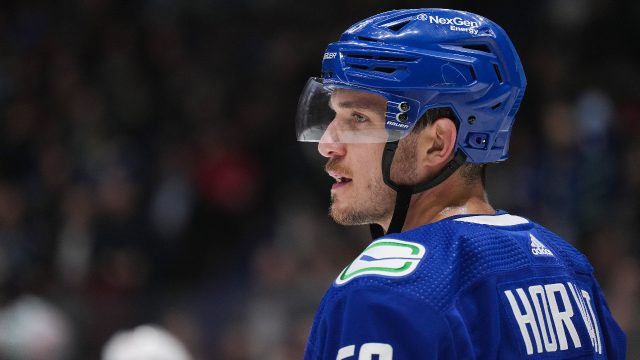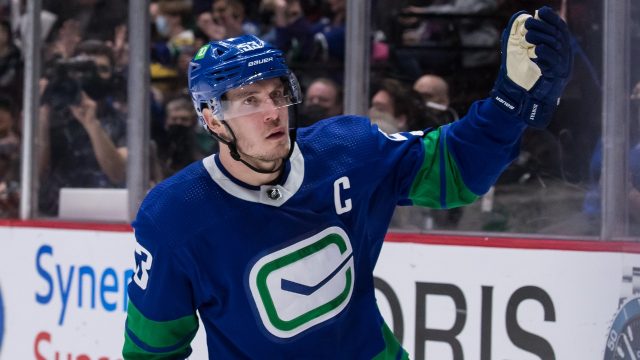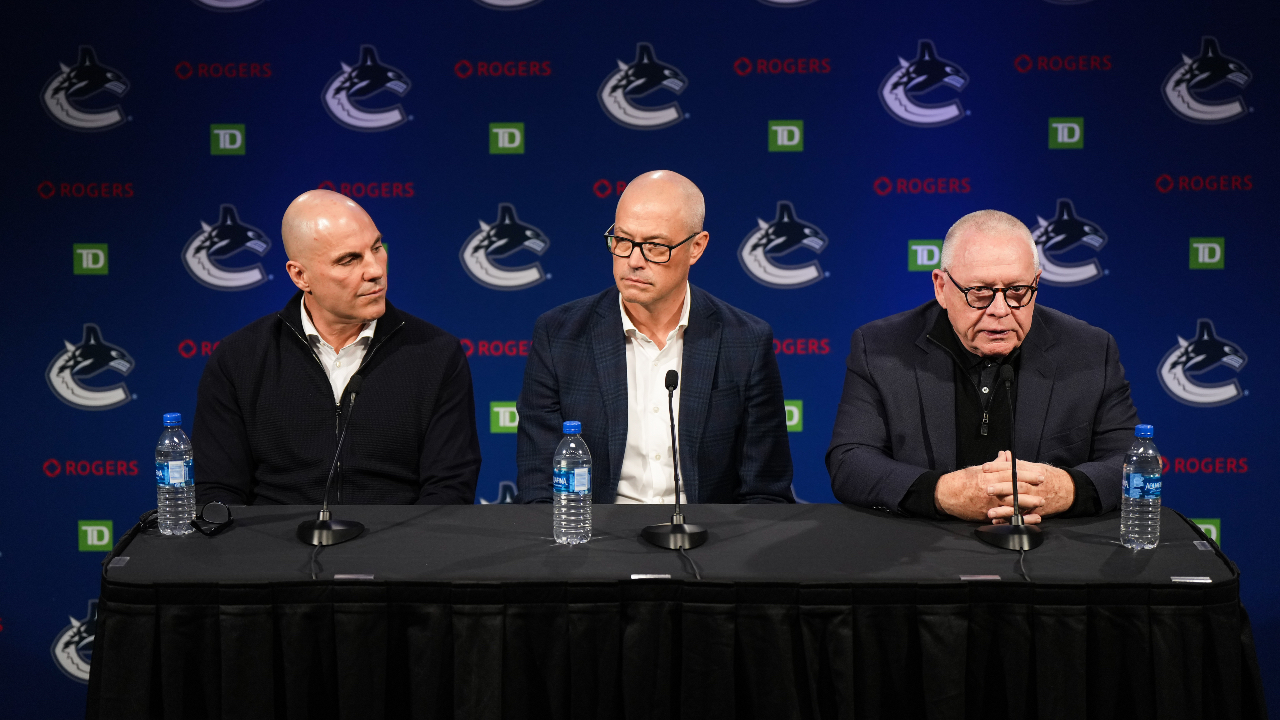
Last week we analyzed the organizational depth, draft capital, prospect pool, and potential needs for the Edmonton Oilers for your consideration in the lead up to the trade deadline.
Vancouver is up next…and there’s a lot to digest with the organization.
Here’s my mid-season analysis of the Canucks:
ROSTER AND SALARIES
Note: Miller’s contract expires following the 2029-30 season and includes a full no-move clause the first four years, followed by a modified no-move clause in the last four years of the deal.
INJURED RESERVE
DEAD CAP
NHL FORWARDS
Like most teams in the league, the Canucks have a “core four” who contribute the majority of team offence up front. Bo Horvat, Elias Pettersson, JT Miller, and Andrei Kuzmenko have contributed 182 points. The rest of the forwards have scored 122 points combined.
Here are my thoughts on the forward group:
Bo Horvat: Horvat is used in all situations. He leads the forwards with just shy of 21 minutes in ice time per game. His shooting percentage is likely not sustainable over the course of an entire season (22 per cent), but he’s positioned himself to potentially score 50 goals this season. He’s also one of the Canucks’ most reliable three-zone forwards. He takes key face-offs and he’s a plus-1. The pending UFA will be traded before the deadline and it’s too bad the Canucks find themselves in the scenario they do with Horvat. The homegrown captain will be missed and contending teams are lining up to acquire him.
J.T. Miller: Miller needs a reset. The season has gotten away from him emotionally. I appreciate his offence and he is on pace for between 75-80 points. It’s a step back from last year, however (99). More perplexing is the fact his overall detail has completely gone off the rails. His off the puck effort as F1 on the forecheck and tracking back to assist defensively has been dismal. He hasn’t been reliable playing centre on any Canucks line and spent a lot of the year on the wing. Half of his points come on the power-play and he has only scored 20 points at even strength the entire season. He’s also a minus-16, which proves just how disjointed his season has been. Miller is just behind Horvat in average TOI. To say the Canucks need more from Miller is a massive understatement.
Full disclosure: I felt Vancouver would be wise to extend Miller, at the right price, last summer, but not at the cost of losing Horvat. It’s going to be very difficult for the Canucks to trade Miller before his new deal (and NMC) kick in this summer.
He might not be a 100-point centreman, but he’s a better player than he has displayed this season. He needs to get out of his own way emotionally and display better leadership.
Elias Pettersson: In my opinion, Pettersson is the most reliable all-round forward for the Canucks this season. He’s used in all situations, leads the team in scoring (54 points), averages nearly 20 minutes of ice time, and he’s a plus-8. Surprisingly, Pettersson also leads the forwards with 50 shot blocks.
I’m keeping a close eye on Pettersson’s contract scenario. He becomes an RFA after the 2023-24 season and his qualifying offer is set at $8.82 million, but I’m positive he will be looking for a long-term deal that is very likely going to be in the $10 million range.
Andrei Kuzmenko: He has transitioned nicely to the NHL. He plays a heavy game from the hash marks down in the offensive zone, and he’s a load to defend around the crease. He’s not a burner in open ice, but has been improving his off the puck detail and defensive zone awareness. Kuzmenko is set to become a UFA after this season. If the Canucks can’t get him extended, I expect him to be moved at the deadline. His cap hit ($950,000) is very affordable, especially considering he is on pace for 30 goals and over 70 points.
Brock Boeser: Things have not improved enough to justify Boeser’s salary ($6.65M). His style of play, and overall impact, is disjointed. It’s somewhat positive that he is on pace for around 20 goals and over 50 points, but consider he’s also a minus-14 and lacks the pace to track up and down the ice to provide three zone detail. He’s on the books through 2024-25. Canucks management granted his representatives permission to seek a trade several weeks ago now, but it’s hard to imagine Vancouver not having to retain a portion of Boeser’s salary in a trade.
Conor Garland: Another player who is not producing enough in relation to his contract. Garland has scored eight goals and 14 assists, with six of his points coming on the power play. That means he has only contributed 16 points outside of the power play. Considering his awful minus-10 rating, the team isn’t getting enough out of Garland. Maybe all he needs a reset as well. He scored 19 goals and 33 assists last year and was a plus-18. When he’s at his best he can be elusive in small areas and creative off the rush, but his game has, unfortunately, fallen off a cliff this year.
Ilya Mikheyev: Mikheyev has played to his identity. It’s possible he will score north of 20 goals and he’s used in all situations. He plays fast. He’s low maintenance, and skates around 17 minutes per game. With 12 goals and 14 assists with a plus-3 he’s one of the few Canucks who has provided relatively consistent effort and results this season.
Curtis Lazar: I’m not sure what to make from Lazar’s game. He’s averaging around 12 minutes per game, with the bulk of his minutes coming at even strength and some secondary penalty-kill. Historically, Lazar has averaged around one point per four games played, but he’s not close this season, with just one goal and one assist overall. I don’t require Lazar to be a “go to “ forward offensively, but his overall game needs more detail. I feel like he needs to know what his role is. It’s up to him to create a consistent identity down the stretch. His pace is fine, he competes, and he isn’t shy about going to the hard areas – but what has he really accomplished so far this season?
DEPTH PLAYERS WITH SIMILAR CONTRIBUTION
Dakota Joshua, Sheldon Dries, Jack Studnicka, Lane Pederson and Nils Aman have all had some positive moments in the first half. There’s a mix of size, decent speed, and reliable compete with this group. The reality, however, is NHL teams need to get more out of their secondary group than what the Canucks have gotten from this set of forwards. With all due respect, this group of players are barely NHL quality. They are a mix of 12th and 13th forwards on most NHL teams.
Stats to consider from these players (combined):
142 GP, 17 G, 15 A, 32 PTS, -33
VASILY PODKOLZIN AND NILS HOGLANDER
The Canucks made a wise decision moving both Podkolzin and Hoglander to, AHL, Abbotsford. Both prospects appeared to be drowning on the Canucks roster. The last thing the organization needs is these players to get away from them – development wise.
Consider the following stats – year over year in the NHL – for Hoglander and Podkolzin:
|
|
2020-21 |
2021-22 |
2022-23 |
|
Nils Hoglander |
56GP, 13G, 27PTS, -4, 15:27 TOI |
60 GP, 10G, 18PTS, -7, 13:07 TOI |
25GP, 3G, 9PTS, -4, 12:03 TOI |
|
Vasily Podkolzin |
N/A |
79GP, 14G, 26PTS, +7, 12:47 TOI |
16GP, 0G, 3A, -2, 12:34 TOI |
Clearly both players were trending down on the Canucks roster. They are being deployed in a variety of roles at the AHL level, though. It’s going to take time for both prospects to play to identifiable elements that project their return to Vancouver.
Here are Hoglander and Podkolzin’s stats in Abbotsford this season:
Hoglander: 13GP, 3G, 4A, 7PTS, +3
Podkolzin: 22GP, 6G, 9A, 15PTS, +6
Hoglander is at his best when he plays a tenacious, quick, and fast style. He has the skill set to make plays in small areas and pressure opponents into turnovers.
Podkolzin is a different player than Hoglander. He projects more as a secondary scorer who can provide physical push back, block shots, and potentially penalty kill as he matures.
NHL DEFENCEMEN
Quinn Hughes: Hughes is playing exactly to his identity. Long before he came into the league, he was projected to be a transitional defender who loves to skate pucks up ice. He quarterbacks the power-play and half of his points come with the man advantage. He’s an elite talent offensively. When you play the style Hughes does, and log 25 minutes a game, there are bound to be some mistakes along the way. He’s far from a perfect player defensively, but his element wins out for me. Vancouver needs to find an appropriate partner for him on their back end.
Luke Schenn: Has been one of the most positive stories for the Canucks. He’s been honest and open with media and fans about the state of the group. His extra layer of leadership has taken some of the responsibilities away from Bo Horvat.
Schenn leads the NHL in hits (221). He’s hard to play against and keeps the game simple with the puck. Having said that, he’s contributed some secondary offence (two goals, 12 assists). He averages 17 minutes of ice time and is deployed at even strength and the penalty-kill.
I honestly thought the pace of today’s NHL game was too fast for Schenn before the start of this season. He’s obviously been drinking from a fountain of youth somewhere. He’s never been fast, but his skating has not concerned me overall.
Vancouver will do better than expected when they move him for assets (hopefully draft capital) before the trade deadline.
Oliver Ekman-Larsson: It’s not the player’s fault he makes the salary he does ($7.26M) or has the amount of years left on the deal he does (four more after this season). Somewhere along the line Arizona decided he was worth the investment – and Vancouver decided to trade for the player and his contract (which also includes a full no-move clause).
The reality is OEL isn’t worth the investment or term. He’s a No. 5 defenceman if he plays on a contending team. He can’t handle matchups versus opponents’ top six forwards on a regular basis. He’s a below average penalty killer and a second unit distributor on the power play (if needed).
OEL is averaging 21 minutes of ice this season and has scored one goal and 19 assists, but his offence has been cancelled out by his team worst minus-18 defensively.
His contract has off-season buyout potential – followed by another team signing him on low end money and OEL playing a more reasonable role at his next career stop.
Tyler Myers: Myers’ contract has one year remaining after this season. His cap hit is $6M and he has a modified no-trade (10-team) clause in his deal.
It will be interesting to see how things play out with Myers. If the Canucks don’t find a trade for him this March they will be on the hook for a $5 million bonus to be paid to Myers on July 1 – meaning he will make $1 million in cash next season.
Is the AAV too much for a team to absorb? Will Vancouver be willing to absorb some of the deal, especially with the bonus payout scenario on the horizon?
Myers has been relatively steady for the Canucks this year. He’s averaged 21 minutes of ice time and chipped in a goal and nine assists. His pace is still NHL standard and he uses his long reach to keep opponents to the outside. The unfortunate reality is he, too, is better deployed as a No. 5 on a good team compared to the top 4 role he plays in Vancouver. He’s not punishing physically and he’s average getting in shooting lanes to block shots.
The Canucks should move Myers for some sort of asset but it’s going to be complicated.
Ethan Bear: Bear is only 25 years young and has potential to land in the Canucks’ top four defenders on a regular basis moving forward. He’s a coveted right shot who has been averaging 17 minutes of ice time. Bear is deployed, mostly, at even strength and the penalty kill. He’s a sound skater who consistently competes. Like all players on this team this year, his execution and detail has room to improve. Overall, however, I’m less concerned about his trajectory than others on the roster. Bear can shoot the puck. It’s a sneaky element of his game he could use more often.
REMAINING DEFENCEMEN
Riley Stillman was acquired in October from the Chicago Blackhawks in a trade that sent Jason Dickinson from Vancouver. The Hawks also received Vancouver’s second-round pick in 2024 in the transaction. Stillman has been limited due to injury, so he will need a full season to establish himself. The left shot defender plays physical, but he needs to keep his game simple to be effective.
Kyle Burroughs is on an expiring contract. It’s been a tough year, playing in only 19 games. He’s a character player, but I don’t see a path forward in a Canucks uniform after this season. Tucker Poolman, on long-term injury reserve, will have his status determined in time.
NHL GOALIES
Thatcher Demko: Demko has been on injury reserve for several weeks and is starting to skate in full gear. I don’t have a crystal ball, but it feels to me like he wasn’t physically right from the beginning of the year.
His previous two seasons ended with consistent GAA’s of 2.85 and 2.72 and exactly the same .915 save percentage. He has only played 15 games this season and his stats have plummeted (3.93 GAA and .883 SV%).
In my opinion Demko was the Canucks’ MVP last season. There were nights the team didn’t deserve to be in games, nevermind escaping with points. It’s unwise to overreact to the way his year started. When healthy he is a massive part of the team’s success.
Spencer Martin: On one hand it’s a nice story that Martin has found his way to the NHL after toiling, mostly, in the minors since turning pro. He has dressed for eight different teams in his pro career. The Canucks are not an easy team to stop pucks for and Martin has a 3.86 GAA and .877 save percentage. I appreciate the effort and the journey but he’s a solid AHL puck stopper more than a consistent, qualified NHL back up.
Collin Delia: Delia was signed by the Canucks in the off-season to fill a role at AHL Abbotsford after playing the past several seasons in Rockford (Chicago’s AHL affiliate). He’s not an NHL goalie. His stats at the AHL level have been pedestrian as well. He’s on the NHL roster out of desperation right now.
TWO INTERESTING PROSPECTS
Moving into a couple of updates on other Canucks prospects, here are some observations on Jonathan Lekkerimaki and Arturs Silovs:
Lekkerimaki: Draft 15th overall in 2022
The scoring forward has had his share of ups and downs this season. Before the world juniors he had only scored one goal playing for Djurgardens (Hockey Allsvenskan Sweden). At the WJC he scored a goal and three assists for Sweden. Recently he has scored three goals and three assists in his last four games split between the Djurgardens men’s team and J20.
The player I viewed at the U18 World Championships in Germany last spring is different than the one I have seen this season when watching Lekkerimaki. He was a scoring machine at the U18’s (6GP, 5G, 10A).
He hasn’t had the puck on his stick enough this season, and at times almost refused to work to win board battles or find second chances around the crease. His element is definitely offence, but I have had to look for him in games this year. He’s capable of more, but his coaches have clearly taken notice of his lack of drive at times. He averaged 10 minutes of ice time at the WJC – the same number he averages at Djurgardens.
There’s a theme with his game that is similar to some of Vancouver’s NHL forwards: He needs a reset. He’s a much better player than he has displayed so far this season.
Arturs Silovs: Drafted 156th overall in 2019
The Abbotsford Canucks goaltender is only 21 years old. His stats at the AHL level have been solid, with a 2.68 GAA and .898 save percentage in 27 games. He’s a big body (6-foot-4, 203 pounds) who plays a butterfly/hybrid style. Silovs is athletic. He has good feet. He’s flexible and can take up a ton of net with his stature. An area he needs to improve, though, is his depth in his butterfly. Silovs tends to sit deep in his butterfly, which makes him smaller in the net. Overall, I believe Silovs has NHL potential. He needs, at least, one more year in the AHL to continue to develop.
DRAFT CAPITAL
The Canucks’ amateur scouting staff is lead by Todd Harvey. General Manager Patrik Alvin is a former scouting director in Pittsburgh, so they both recognize the value of drafting and developing prospects.
Harvey is in his second year as a scouting director. I know how hard he, and his staff, are working towards the 2023 draft. The draft class is exceptional and the Canucks have an opportunity to add more draft capital to the grid below:
SUMMARY
I can’t sugar coat my opinion: The Canucks are swaying in the wind in far too many team categories. The NHL roster has some horrible contracts, players in need of new deals, others who need to play to their identity – and provide better overall leadership.
The organization is also in need of more prospects to fill out their depth. Vancouver currently have six picks in 2023. They would be wise to add as many picks as possible, for this draft, through deadline trades. This team isn’t in “retool” mode. They need a full-on renovation. It will be painful for a couple years, but it’s time to strip things down to the studs and rebuild through the draft and youth.
Contract and draft pick images courtesy CapFriendly








